#its more like most people newer to the plural community
Explore tagged Tumblr posts
Text
I just realized I don't think most of the plural community knows what source vs. canon is, so...
Canon is the specific world someone is from, more associated with fictional identities that experience memories. For example, someone who's kin to a Pokemon character might have their canon be one where Pokemon can speak.
Source is the specific source material that someone has a fictotype from. Using the above example, the source would just be Pokemon.
Both were coined by fictionkin! "Source" specifically just got used by the plural community because introjects in particular don't usually have canons, but non-introject fictives might.
#small tag clarification becuase our wording might be wrong#its more like most people newer to the plural community#actuallymultiple#pluralgang#plural community#fictive#fictives
7 notes
·
View notes
Note
What do you think of this anti endo's response here?
https://www.tumblr.com/cloudpeoplesys/756660678138413056/if-a-theory-is-still-heavily-backed-its-going-to?source=share
In short, it's bad.
In long...
It's really, really, really bad.
Might as well get into it.

I agree with the first part that most academic sources are reliable until disproven. We'll get back to how they're misapplying the structural dissociation model later.
Although this post is already instantly concerning in that they're implying a New York Times article is unreliable because it's not on a .gov domain. This is American Middle School-level thinking.
And they're cherry-picking the few sources that are that old, when most are from the last decade and many as recent as last year
It should also be noted that there's a big difference between news sources and scientific sources when it comes to age. The 1979 NYT source is for the Dalai Lama, the highest authority in Tibetan Buddhism, stating that religions the West could use their meditations. While older scientific sources may become less reliable as new findings emerge in the field, a quote from the Dalai Lama is going to be relevant until the Dalai Lama says something that suggests his opinion has changed.

Basically, this seems to be in reference to the Youth and Policy Center saying their editors don't have time to make detailed corrections.
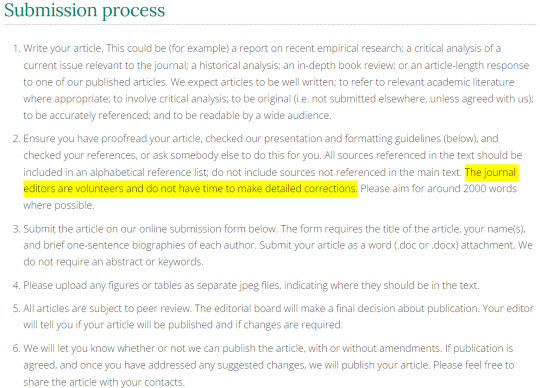
It does NOT say editors won't check to see if the sources are reliable. Just that they won't make detailed corrections themselves.
They also conveniently gloss over the fact that it's stated all articles here are subject to peer review.

Like I said. Middle school-level thinking.
This is just completely untrue, and grown-ups in higher education learn to check the reliability of the publications. Not the domains that happen to host the articles.

In general, sure. 🤷♀️
But social media posts, for the most part, are reserved for the community explanations section and parts about plural history. Not treated as academic sources.
Actually though, why is Reddit listed first? That kind of jumps out at me, because Reddit isn't sourced very often, and I think it's actually referencing the AMA with Dr. Lifshitz and Dr. Luhrmann.
I'm not certain, but this seems a popular conspiracy theory with anti-endos who are in denial about this study. The theory basically goes that the AMA isn't real and the people behind it are just pretending to be doctors.
Something which is absolutely wild when both are names of real people who have published works, including studies into tulpamancers.
Essentially, for the AMA and the FMRI study to be fake, you would have to believe that mods of multiple tulpa communities coordinated for years to create an elaborate hoax where they started gathering participants for this fake study in 2019. They created multiple accounts to pretend to have participated in it. They then faked an entire AMA by impersonating these very real doctors, knowing the entire thing would come crashing down if either real doctor found out they had been impersonated. And this would damage future research, because again, they have both published works about tulpamancy.
It's difficult to put into words the sheer ridiculousness of such a belief. It's frankly on the level of Q-anon conspiracy theories.

I don't know what "medium section" it's talking about.
The first article that mentions mediumship in the document is Dissociation in Trauma: A New Definition and Comparison with Previous Formulations.
This is cited by 177 different articles.
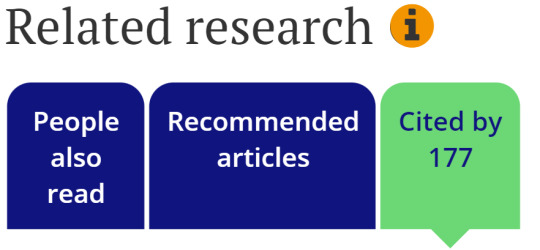
(I'll talk more about this later. Don't forget that article.)
The next one about mediumship, Comparison of brazilian spiritist mediumship and dissociative identity disorder, is cited by 16. (The results say 17, but one of those is the article itself. No clue why it's counted as citing itself.)
The ones with fewer citations are, unsurprisingly, newer papers.
It's likely that most papers published in the past few years won't have many citations.
Which is a bit of a catch-22.
Sources that are too old, anti-endos will say aren't valid because of how old they are. But new sources are bad because nobody has cited them. It's a great tactic if your goal is just making up excuses to pretend none of the evidence against you is real.
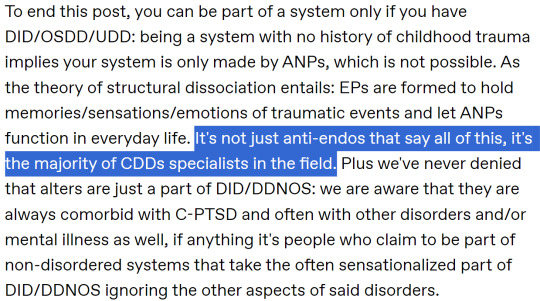
Yes, finally, we reach the end where we can talk about how sysmeds don't actually understand the theory of structural dissociation.
Let's take a step back and revisit that article, the first one to mention that mediumship in the document, that had 177 citations.

They may, if they looked, recognize these names. Because they're two of the same names from the first source they posted:
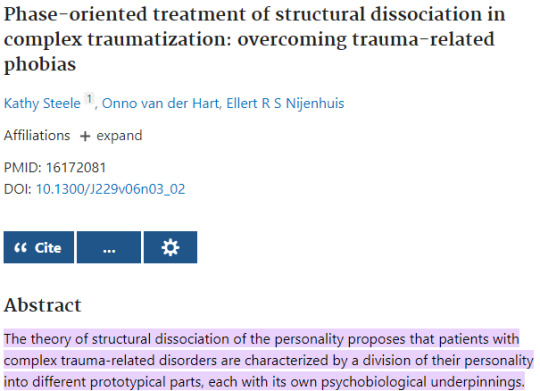
Notice, by the way, that this source never once claims that this is the only way to experience multiple dissociated parts. It only says that this is how they work in trauma-related disorders.
Going back to the new definition of dissociation though and what it actually says.
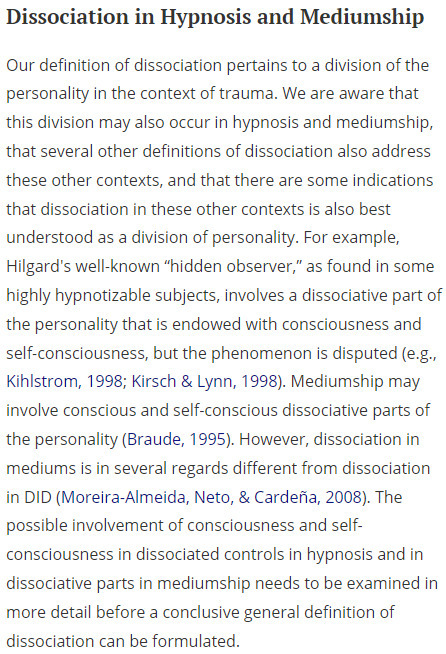
These are the creators of the theory of structural dissociation explicitly saying that there may be other ways for self-conscious dissociative parts of the personality to form.
And this is five years AFTER the article the OP sourced, from the same exact authors.
So the creators of the theory of structural dissociation have said, in essence, that you can possibly be a system without trauma after publishing their theory.
They specialize in trauma, and their theories only apply to dissociation caused by trauma.
Anyone who tries to say these authors are arguing that you can't have dissociative parts without trauma is lying and misrepresenting their views.
And the stupidest thing about this is that it probably wouldn't even matter to the OP
I'm almost certain that if you presented them with this fact, the OP would argue that Ellert R Nijenhuis and Onno van der Hart are super reliable sources when their article happens to be hosted on a .gov domain, but you can't trust those same exact authors when their peer reviewed papers are hosted on a .com domain instead.
That's what happens to your brain when you're focused less on knowing the truth, and more on making up reasons to dismiss the other side out of hand.
#syscourse#pro endogenic#pro endo#systempunk#syspunk#psychiatry#psychology#structural dissociation#dissociation#science#plurality#plural things#endogenic#multiplicity#systems#system#plural system#sysblr#actually plural#actually a system
18 notes
·
View notes
Note
My hot take is similar to the the other anon: Origin doesn't matter. Experience matters. Trying to understand why our brains work the way they work and living life as peacefully and functionally and contentedly as possible matters. When I was very young, before the internet and plurality, and trying to understand myself and quirks, what mattered was how to keep living. What hurt was when I found the communities and started using that language because Finally! Someone! Understands! to eventually get torn down by both sides because I was telling my experiences and it didn't fit in either box.... That hurt the most. One box or the other, whichever I tried in later decades... the boxes made matters worse.
I understand why both sides are so passionate, but by golly are they destructive. Destructive to minors. Destructive to not minors who Don't Know. Destructive to those trying to discover. Destructive to those who thought X when Y was true but only had X vocabulary when venturing to the other side, only to get harrassed. Because so many refuse to acknowledge nuance or a variety of experiences.
I watched a whole Discord group gang jump someone here on Tumblr once. Maybe one day I'll be brave enough to tell that person. But I suspect they know. I suspect they get it a lot. Just because they're willing to (rather kindly, calmly, and matter of factly) give a different view.
There are a few people on both sides of the issue now that I'm older, more solid, and have spent some decades digesting the community who I like and trust. Agree with? Not always. I like the people who are able to point to the history the best. The ones who either have either been around long enough to remember or the ones willing to acknowledge how the community has evolved over the years.
My hottest take is that the ones who have only been around a couple of years are often the most destructive. They can't handle the nuance yet. And I don't trust them even with their sources because of their delivery. Not ALL. Not all on either side. But generally. My hottest take is that we shouldn't be bitterly fighting one another. We should be learning how to best live. All of us.
Time tells all. Do I fit? Not in the round peg or the square. I'm a wobbly piece that goes no where. But do I fit? Yes. And so do the others floating by that have been around for some time. And maybe some of the newer guys too.
But gee, take a chill pill and realize what your words and rants can do to others. For once. A lot of you people are bullies hiding behind principles. And that behavior shouldn't be accepted by any side.
this kinda feels like a poem. that's not a bad thing, it just... kinda sounds like a poem.
you have some good points here. i think origin does hold importance and meaning, because at its best it can help us understand ourselves and seek out the appropriate respective groups and resources.
but the way we talk about it is a problem. whether we like it or not, plurality isn't always black and white, and that's okay, but, as with everything in life, gray areas need to be handled with care and nuance, something that a lot of people don't seem willing to do.
8 notes
·
View notes
Photo
I am mind-boggled and in awe right now at how social media just. Went flash like lightning and /flaps hands vaguely/ Just with the. Just like
First it was like 2004 and I was on a listserv I'd started for genderqueers, and on another for multiples. (Which I'd only found out existed because of someone I'd met on the genderqueer one.) I was out to everyone as genderqueer, and out to a select few as multiple.
I blogged about both, on LiveJournal. I knew lots of people who were one or both, because listservs. But it was still a time where most people didn't know what either one was.
Where I had to be prepared to explain either thing to people if I wanted to bring it up. (And I'd often start with, "do you know what _____ is" just to see where we stood.) Where I was often the one to explain them to people just so that I could gently (?) bring them to the realization that these labels applied to them.
And then life happened, I guess? Listservs fell apart. People migrated to social media. I was very focused on recovering from abuse and its effects, and that community largely took the place of the queer/trans/plural ones for me for a while.
I swear to god I turned my back for like five minutes. Or five years. It feels like both.
Then I realized that I could either get on Tumblr, or have virtually no idea what Kids These Days were saying and doing ever again. I chose Tumblr.
Basically, I rejoined the public instead of hanging out solely with people I knew.
And somehow, the world?? was now?? a place where all of these things were common knowledge? Where they were now mostly called being "nonbinary" (oh, we have a word we can say in front of the straights now?) and "plural"? (smart move; searching for "multiples" always used to turn up a lot of stuff from people who'd had twins.)
A world where it seemed like most people were queer and/or trans?? Where people talked openly about being plural???
I thought that was all there was to it.
But fast-forward eight years or so.
Now, people have been talking openly about their experiences for long enough that more than a third of Gen Z is in the quiltbag.
People have been talking about their experiences for long enough that when I had to do a custody hearing a few months ago, the judge took time first to make sure she had all of our pronouns right: they, he, and gem. And to find out whether we each wanted Mr, Ms, or Mx.
People have been talking about their experiences, publicly, in a manner that is widely accessible, for long enough that a friend of mine - who is 10 years younger - just had a realization about giving answers they would never normally give to a partner's questions, rapidly connected all the dots, and went, "well, looks like I'm plural."
I had been thinking about letting them know that a new mutual friend, who I met in that long-ago listserv, was plural.
But oopsie-doodles! I no longer need to. Because they're both nonbinary. And they both went to a trans zine workshop together today.
The newer friend shared a link to this very post in our group chat. And casually goes, "We just found out that we are all plural here"!
I feel like, BOOM. I just FAST-FORWARDED from "nobody knows what this is and you have to gently introduce the idea" to "it's general knowledge and people can figure it out easily on their own, without a lot of stigma!"
And while I type this? My six-year-old is in the other room, happily explaining to our (also nonbinary) housemate that the main character in his new special interest, Billie Bust Up, is nonbinary.
Also: this is why the Christian Nationalists, who are trying the genocide again, are going to lose.
They've already lost. They are so incredibly far behind the times that their entire plan is pretty much hopeless.
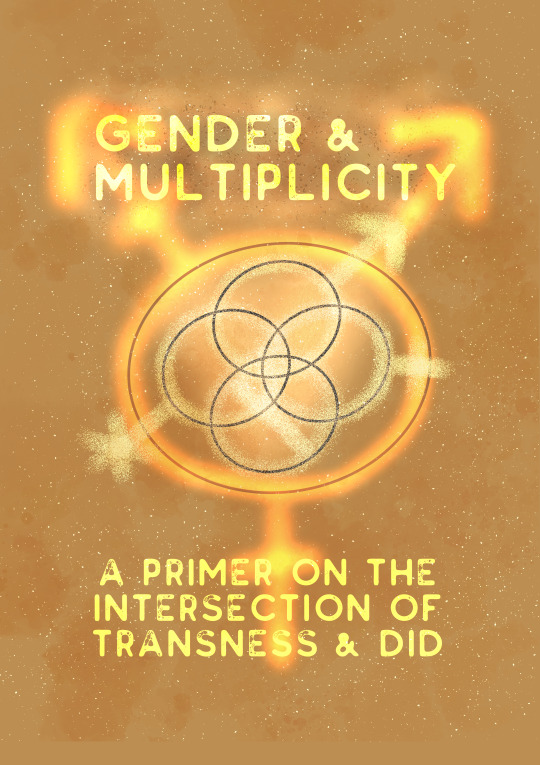

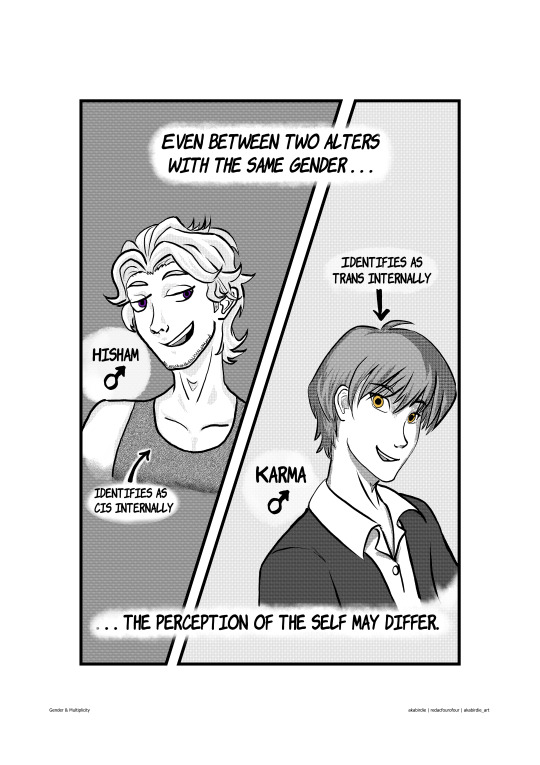

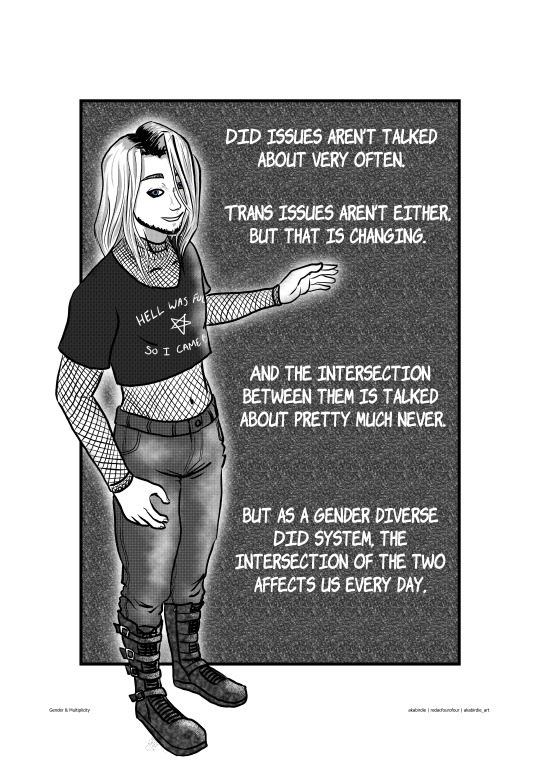


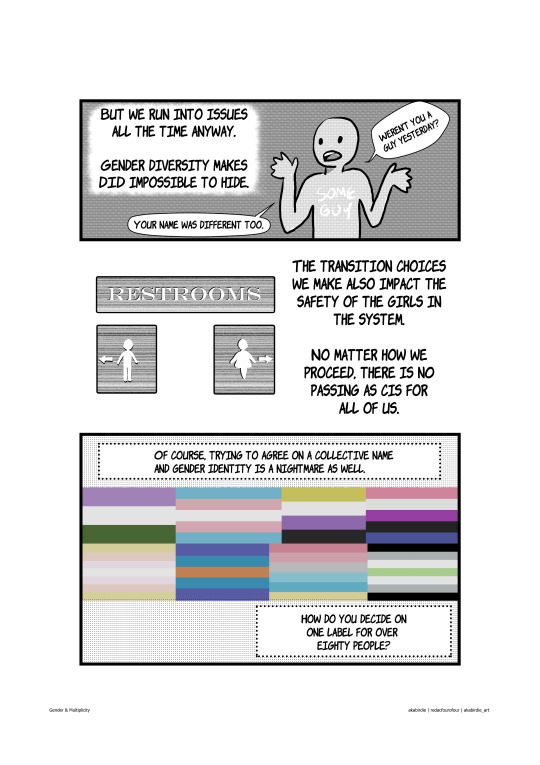


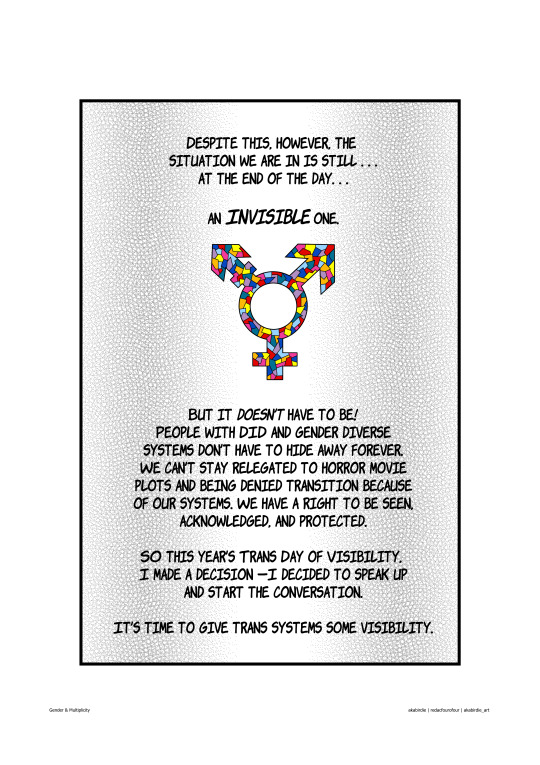

Gender & Multiplicity: A Primer On The Intersection of Transness & DID REDAC FourOFour Spring 2023
Keep reading
#although to be fair their chokehold on HRT is a very bad thing#everything they're doing is very bad things. they're just also losing#wall of words#baby x#autistic parenting#billie bust up#is a nonbinary aroace goat#this world is really incredible#A NONBINARY AROACE *GOAT*#with magical powers!#it's a game that's not out yet but if you follow the patreon for $5 you can download and play the pre-alpha demo#this kid is an EARLY early adopter#probably all of Gen Alpha will be#which also doesn't bode well for the bigots!
4K notes
·
View notes
Text
U obviously don't understand the multi verse idea kiddo. its speculation on mephisto from a 3 min trailer which makes sense (IF U HAVE READ THE COMIC'S. OBVIOUSLY U DIDN'T) on top of that saying people a hyped about the billings from 20 years ago of course !!!! They grew up on them kid ITS A MULTI- VERSE they ! Can be different versions of the villians too so they won't destroy the characters from 17 years ago kid
First of all I’m thirty goddam years old so who the Hell are you calling a ‘kid’, son?
Second of all I’ve been a Spider-Man fan for at least 25 of those years and a comic book fan for about 20 of them.
During that time I even worked for a British publisher as an image researcher for officially licensed Marvel and DC guidebooks. Whilst working there the higher up editors on occasion came directly to me specifically to explain or proofread various confusing pieces of comic book lore to them (and on occasion write scant pieces of copy for the books). This included who various characters were in the Spider-Verse arc, a storyline constructed around the concept of the multiverse. My work also included communicating with representatives of DC who laid out for me their internal policy for defining when one version of one character ends and another begins because the nature of their own multiverse has included reboots.
So where the FLYING FUCK do you get off claiming I’ve not read the comics and don’t understand the multiverse? I’ve written a goddam 30K fanfic around the concept of a multiverse. I was introduced to the concept as a child in the very first piece of Spider-Man media I ever consumed, the 1994 Spider-Man cartoon. I’ve got a wardrobe full of Spider-Man trades and organized them by which universe the stories take place in and in what order those universes were first published. And I’ve got an entire side blog dedicated to ESSAYS about Spider-Man and know Spider-Man lore you’ve never even mother fucking thought of. I know Mary Jane’s canonical ringtone!*
Don’t you EVER test me on my fan credentials kiddo, I will goddam wreck you every time.
Moving on, yes it is speculation. It’s speculation that Mephisto, a character who’s introduction into the MCU has been discussed in fandom since early this year with WandaVision, who’s a villain who’d fit perfectly into the world of Doctor Strange, who Marvel now definitively have the rights to and who was the main villain of the storyline that is the direct inspiration for a major plot point in this movie.OH NO! How foolish of me for raising the idea they might include him! Marvel would never use a Spider-Man movie to introduce plot elements for the wider universe that aren’t directly connected to Spider-Man himself... like Skrull impersonators...
Next, if you bothered to read what I wrote, what I said was:
“P.S. It says far too much that the things getting people hyped the most for this movie is stuff that was in older Spider-Man movies from nearly 20 years ago…”
“P.S. It says far too much that the things getting people hyped the most for this movie is stuff that was in older Spider-Man movies from nearly 20 years ago…”
“P.S. It says far too much that the things getting people hyped the most for this movie is stuff that was in older Spider-Man movies from nearly 20 years ago…”
“P.S. It says far too much that the things getting people hyped THE MOST for this movie is stuff that was in older Spider-Man movies from nearly 20 years ago…”
“...THE MOST...”
As in, yes they are getting hyped for the other stuff but it says something derogatory about the other, newer, stuff that people are the most hyped about the OLD stuff from this entirely different version of Spider-Man. Almost like it’s cheap nostalgia bait on Disney’s part (just like the Star Wars Sequels) and that people actually liked those older Spider-Man movies more.
“They grew up on them kid ITS A MULTI- VERSE they ! Can be different versions of the villians too so they won't destroy the characters from 17 years ago kid”
You know how sentences work right? You were supposed to say: “They grew up on them kid ITS A MULTI- VERSE, they can be different versions of the villains too! so they won't destroy the characters from 17 years ago kid!”
So, for starters if you are referring to villainS in the plural, i.e. Green Goblin and Doc Ock, Green Goblin was from the first movie which was 20 years ago. But maybe you are too young to remember that, son.
More importantly, I fucking mentioned this in the original post you imbecile:
“I’ll settle if we learn that Doc Ock and the other Raimi villains are in fact from a universe merely similar to the Raimi movies (i.e. where Doc Ock never died) but I’m not hopeful for that.”
If you weren’t still learning how to read you might’ve noticed that I didn’t say they couldn’t be alternate versions of the original movie villains. I specifically raised that possibility but also said I wasn’t hopeful of that.
You can try and respond to me again junior if you want. I’d love to smack you down some more. But if you want to actually try and own me you are about 20 years too early and 100 IQ points short of doing that.
*It’s the musical cues from the film ‘Clone Encounters of the Third Kind’ as established in Amazing Spider-Man volume 2 #53, just in case you want to test me. Go ahead and check for yourself, it’s on the very first page of the issue.
To lazy or in experienced with the comics to do that? Okay, then let me pull up the page from my giant goddam digital archive of nearly every Spider-Man comic book ever:

#Spider-Man#Peter Parker#Spider-Man: No Way Home#Mephisto#mcu#marvel cinematic universe#Marvel Studios
19 notes
·
View notes
Text
Having the Time of My Life Overanalyzing Voltron Science, A Visual Novel
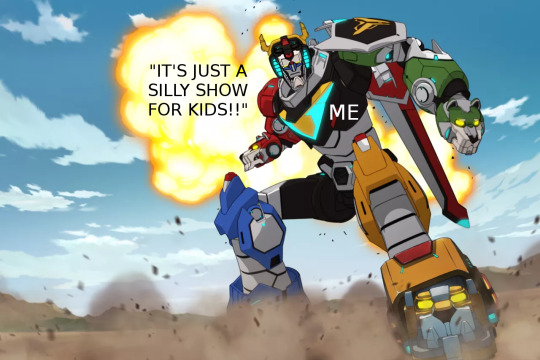
The team’s little mantra in the original show was “ Activate interlock! Dynotherms connected! Infracells up! Mega thrusters are go! Let’s go Voltron Force!” And they said this each and every single time their 5 lions formed together into the combined robot.
In today’s essay I will be deeply examining and wildly speculating about what exactly interlocks, dynatherms, infracells, and mega thrusters are, why it’s entirely crucial that these 4 items be part of the Voltron preflight checklist, and explaining why (or at least inferring that) you should take it all seriously.
Interlock
The Interlock is easy. It’s probably whatever system is used to attach the 5 lions together. So what are they? Magnets? Docking rings like on spacecraft? Just mechanical latches? Hard to say. But something as simple as a mechanical latch isn’t something you’d have to ‘activate’ or actively call out during pre-flight, so I would suspect ‘interlock’ is likely a catch-all term for not only the mechanical attachments, but also the control circuit used to synchronize the computers onboard all 5 lions. It would be a complex integrated system within the black lion, which also explains why they refer to it in the singular instead of plural.
Without the interlock, Voltron would just be the 5 lion with their individual brains tied together like duct-taped dogs. The interlock synchronizes them into a common intelligence, under the direction of the centralized black lion.

I don’t know what the mechanical structure of the interlocks would be. Conventional material science would suggest that a robot as large as Voltron wouldn’t be able to even stand, let alone run and jump and fight, so even if we assume nearly-indestructible exotic alien materials, I think you would still want something more than hooks and pins to connect the various pieces together. It would be best if the actual structural elements could somehow fuse at the molecular level. Welding is the most obvious method for that, but there’s also Vaan-Der-Waals forces, which could bond together flat surfaces that could then be slid apart. And maybe if you had superconducting cables running between the elements and then ran a ton of current through them, then you could use magnetic binding? I’m not sure if that would work, but it sounds futuristic enough to be true. IDK.
Dynatherms
I can’t tell if this is ‘dynatherms’ or ‘dinotherms’, but the first sounds less prehistoric, so I’ll go with that. So it sounds like pieces of the words ‘dynamic’ and ‘thermal’ mashed together, which don’t really mean anything except in the context of thermodynamics, so.... What is this? A reactor? A steam engine?
Of all the various components this one puzzled me longest, but I think I’ve got it.
The dynatherms are the cooling system, meant to radiate away the massive amounts of heat its engines and motors would generate. Most spacecraft, heck most vehicles in general, have a system analogous to this. Here’s the one the ISS uses:

Voltron doesn’t have any weird extendo-wings like this, but it’s conceivable that they could be built directly into the outer layer of its armor. The black lion’s little red wings are likely a part of the system too. If you ask me, the surface area of its armor isn’t nearly enough to dissipate enough heat to keep a thing like this cool, but I think I can ignore that.
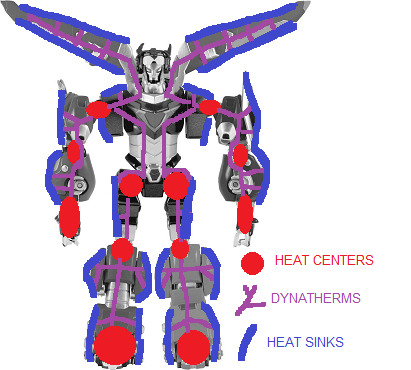
So anyway. At first this explanation doesn’t seem to fit, since they say ‘dynatherms connected’, not ‘coolant pumps started’ or ‘refrigerant levels maximum’ or something. You don’t ‘connect’ the heat radiators, they’re always connected. You just pump water through them. Right?
Wrong! Here’s my sufficiently futuristic explanation: Voltron’s cooling system doesn’t use coolant and pumps or any type of conventional refrigeration at all! Instead, the ‘dynatherms’ are a network of thermally superconductive cables connecting all its motors and engines to radiative armor panels on the exterior. Thermal superconductivity is a concept I learned from Star Wars and later found out is a real-ish thing. Basically any vibrations in any part of a thermally-superconductive material can frictionlessly travel to any other part of the material. Since temperature is based on vibrations, this means that if a hot thing touches one part of the material, everything else touching the material can instantly feel that heat, and even dissipate that heat. You can think of it as Marvel vibranium or as warmth communism.
Since there’s no fluid flow, the only way to control this cooling system or increase or decrease its dissipation is to connect and disconnect individual cables. Hence why they would have to connect the dynatherms before forming Voltron; combat in combined robot mode is one of the most taxing conditions of the machine’s operation, so they need all the cooling they can get.
Infracells
Now HERE’S where it starts to get interesting. ‘Infra’ roughly means ‘below’. To take the most common example, take ‘infrared’ light, that is, light existing at frequencies lower red light, which is itself the lowest frequency in the visible spectrum. Infrared is invisible, so the only way to describe its color is ‘somewhere below red’.
So as far as I can tell, ‘infracells’ could mean one of three things. They could be some kind of infrared light sensors, like FLIR imagers used for night vision and targeting on modern military equipment (which I consider unlikely, since that’s not the type of thing you would specifically call out during the preflight, or something intrinsically useful to the Voltron assembly process.) Or it could be an armor layer consisting of some kind of cells literally ‘below’ the rest of the armor (which I also consider unlikely, because why would that be important to the Voltron assembly either? You wouldn’t need to even worry about it until you take damage to the outer armor layer, right?) Or, finally and most interestingly, it could have something to do with lower frequencies or lower speeds in general.
Here’s my theory:
The infracells cause time itself to run differently. You all saw the movie Interstellar, where time aboard the spacecraft passed slower for the crew whenever they were inside powerful gravity wells. If you had high buildups of negative energy within cells inside Voltron, it would produce the opposite effect, causing time to move faster inside the cells than outside. Anything inside would experience the rest of the universe in slower motion, meaning lower acceleration, lower forces, and lower stress.
Therefore, if such ‘infracells’ were installed around Voltron’s skeletal frame and motors, it may explain the machine’s great strength and indestructibility. And it would make sense that this would be the type of thing they would call out during the pre-flight, as even one down infracell could spell disaster once that section of the frame is attempting to support the entire weight of the robot; it would buckle and break. Every infracell needs to be up before forming Voltron.

Mega thrusters
Now, this just sounds silly. They’re likely the engines that Voltron uses to fly, but the show creators put ‘mega’ in front of the name to sound cool. Might as well call them ‘super rockets’ or ‘the ultra drive’, right? But mega is an interesting word, as it’s actually a scientific term in the metric system meaning to multiply by a million. Like a kilometer is a thousand meters and a kilogram is a thousand grams, a megameter is a million meters, and a megagram is a 1000 kilograms. You may have heard of ‘megaton’ when referring to nuclear explosives; a three-megaton bomb is a bomb with the explosive yield equivalent to three million tons of TNT. A lot.
So, uh,

Why would you call a thruster a ‘mega thruster’, then?
Well, I know approximately jack-diddly about the original show, but I know that in the newer show, most large spacecraft in the universe get their energy not from nuclear reactors or solar cells, but rather from Balmeran crystals. The crystals are able to produce apparently infinite energy so long as you don’t damage them or overtax them. I don’t know where the crystals get their infinite energy, but that’s not what I’m here to speculate about, so I’ll just treat that as one of the universe’s rules, like bending in Avatar.
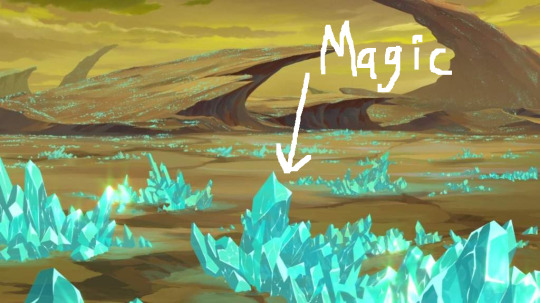
So! How do you set that up to make an engine? Well, infinite power is good! Higher power to the engine means hotter, faster exhaust, and hotter, faster exhaust means higher fuel efficiency and higher thrust. So the question becomes, how do you get the most power in the safest and most efficient way possible?
For the sake of some rules, let’s say that you need to give the crystals a little bit of stimulating energy to make them produce energy. That seems fair, I think. Let’s say they produce 5 times the energy they absorb.

So you give a crystal 1 watt, you get 5. That’s great; that means if we need 50 billion watts to run the thruster, we just need to get a big crystal, and feed it 10 billion watts. However! Where do we get that initial 10 billion watts? Well we could just take a portion of the crystal’s own output and cycle it back around to the input, but that’s a dangerous game to play, since if the percentage you cycle around is even slightly more than 20%, you could create a “positive feedback loop” where more input means more output, which leads to greater input which leads to even greater output, and so on and so on until the crystal breaks or the ship blows up or something generally unfavorable happens. This is approximately the experience of the people at Chernobyl, and is not recommended.

So instead of having crystals feed themselves, you’d instead want them to be fed exclusively by an external source, like a battery or an entirely separate smaller crystal. So the initial crystal would feed larger ones, which would feed larger ones, and so on, each stage in the chain becoming more powerful, but always stable and dependent on some initial external input, so as to never go out of control.

And now, I’m thinking it would be nice from an engineering perspective to have all the crystals together in one shielded location. And from a tactical perspective, it would be nice not to have a bunch of bulky, vulnerable, high-energy cables running around the entire vehicle. So, you would want as many crystal stages as possible in the places where the power is needed most. Namely, the engines.
Therefore, a big part of the engines would be made of armored shells to contain dozens of stacks of crystal beds. They would accept a small amount of power at the top, and multiply it internally to get enormous output at the bottom. Hence, ‘mega’ thruster. It multiplies input by a million.

Boom.
Done.
Headcanon deployed.
So now the next time you’re watching some stupid show and think that something doesn’t make sense, pause to consider that maybe you’re just not using enough imagination, or else I will be with you in spirit to wrong-shame you.
(If you use your imagination and it still doesn’t make sense, then don’t worry. This means that the show is trash and you are right.)
Now go to bed.
#Boom#Voltron#voltron: legendary defender#lion#fan theory#engineering#some cool food for thought#I don't even watch this show what am I doing
9 notes
·
View notes
Text
How John Stuart Mill and Harriet Taylor’s Pioneering Intimate Partnership of Equals Shaped the Building Blocks of Social Equality and Liberty for the Modern World
“They were imperfect, divided people and went on being so for the rest of their lives, with the rueful knowledge of human contradiction that good people always have.”
Half a century after the 18th-century political philosophers Mary Wollstonecraft and William Godwin pioneered the marriage of equals, and just as Ralph Waldo Emerson and Margaret Fuller were contorting themselves around the parameters of true partnership, another historic power couple modeled for the world the pinnacle of an intimate union that is also an intellectual, creative, and moral partnership nourishing not only to the couple themselves but profoundly influential to their culture, their era, and the moral and political development of the world itself.
In 1851, after a twenty-one-year bond traversing friendship, collaboration, romance, and shared idealism, John Stuart Mill (May 20, 1806–May 8, 1873) and Harriet Taylor (October 8, 1807–November 3, 1858) were married. Mill would come to celebrate Taylor, like Emerson did Fuller, as the most intelligent person he ever knew and his greatest influence. In her titanic mind, he found both a mirror and a whetstone for his own. They co-authored the first serious philosophical and political case against domestic violence. Taylor’s ideas came to shape Mill’s advocacy of women’s rights and the ideological tenor of his landmark book-length essay On Liberty, composed with steady input from her, published shortly after her untimely death, and dedicated lovingly to “the friend and wife whose exalted sense of truth and right was my strongest incitement.”
In his autobiography, Mill painted a stunning portrait of Taylor:
In general spiritual characteristics, as well as in temperament and organisation, I have often compared her, as she was at this time, to Shelley: but in thought and intellect, Shelley, so far as his powers were developed in his short life, was but a child compared with what she ultimately became. Alike in the highest regions of speculation and in the smaller practical concerns of daily life, her mind was the same perfect instrument, piercing to the very heart and marrow of the matter; always seizing the essential idea or principle. The same exactness and rapidity of operation, pervading as it did her sensitive as her mental faculties, would, with her gifts of feeling and imagination, have fitted her to be a consummate artist, as her fiery and tender soul and her vigorous eloquence would certainly have made her a great orator, and her profound knowledge of human nature and discernment and sagacity in practical life, would, in times when such a career was open to women, have made her eminent among the rulers of mankind. Her intellectual gifts did but minister to a moral character at once the noblest and the best balanced which I have ever met with in life. Her unselfishness was not that of a taught system of duties, but of a heart which thoroughly identified itself with the feelings of others, and often went to excess in consideration for them by imaginatively investing their feelings with the intensity of its own.
In A Thousand Small Sanities: The Moral Adventure of Liberalism (public library) — an elegant, impassioned, and rigorously reasoned effort to re-humanise the most humanistic moral and political philosophy our civilisation has produced — Adam Gopnik argues that Mill and Taylor pioneered something even greater than a true marriage of equals on the intimate plane of personal partnership: a vision for the building blocks of equality on the grandest human scale.
Gopnik — a Canadian by birth, a New Yorker (and longtime New Yorker staff writer) by belonging, and one of the most lyrical, lucid thinkers in language I have ever read — recounts trying, and failing, to comfort his intelligent, politically engaged, disconsolate teenage daughter in the wake of the 2016 U.S. Presidential election. For consolation and clarity, as much hers as his own, he turns to Taylor and Mill:
My idea of liberalism, while having much to do with individuals and their liberties, has even more to do with couples and communities. We can’t have an idea of individual liberty without an idea of shared values that include it.
A vision of liberalism that doesn’t concentrate too narrowly on individuals and their contracts but instead on loving relationships and living values can give us a better picture of liberal thought as it’s actually evolved than the orthodox picture can.
[…]
Images illuminate ideas, and pictures of people are usually clearer than statements of principle. When I think about the liberal tradition I wanted to show my daughter, my inner vision kept returning to a simple scene, one that had delighted me for a long time. It’s of the nineteenth-century philosopher John Stuart Mill and his lover, collaborator, and (as he always insisted) his most important teacher, the writer Harriet Taylor. Desperately in love, they were courting clandestinely, and they would meet secretly at the rhino’s cage at the London Zoo. “Our old friend Rhino,” Taylor called him in a note. It was a place where they could safely meet and talk without fear of being seen by too many people, everyone’s attention being engaged by the enormous exotic animal.
They were pained, uncertain, contemplating adultery, if not yet having committed it — opinions vary; they had been to Paris together ��� and yet in those conversations began the material of “On Liberty,” one of the greatest books of political theory ever written, and “On the Subjection of Women,” one of the first great feminist manifestos and one of the most explosive books ever written. (One of the most successful, too, inasmuch as almost all of its dreams for female equality have been achieved, at least legally, in our lifetime.)
With an eye to the perilous erasures with which history is often rewritten — history, I continue to insist, is not what happened, but what survives the shipwrecks of judgment and chance — Gopnik points to the curious disconnect between Mill’s own repeated affirmations of Taylor’s supreme influence on his ideas, and subsequent warpings and appropriations of their story:
After [Mill’s] life, generations of commentators — including Friedrich Hayek, who unfortunately edited their letters — aggressively Yoko-ed [Taylor], insisting that poor Mill, wildly intelligent in all but this, was so blinded and besotted by love that he vastly exaggerated the woman’s role, which obviously couldn’t have been as significant as his own. Fortunately, newer generations of scholars, less blinded by prejudice, have begun to “recover” Harriet Taylor for us, and her role in the making of modern liberalism seems just as large and her mind as fine as her husband always asserted that it was.
Gopnik reflects on the intellectual and ideological resonance at the heart of Mill and Taylor’s love, which in turn became the pulse-beat of our modern notions of political progress:
What they were was realists — radicals of the real, determined to live in the world even as they altered it. Not reluctant realists, but romantic realists. They were shocked and delighted at how quickly women and men began to meet and organise on the theme of women’s emancipation, but they accepted that progress would be slow and uncertain and sometimes backward facing. They did more than accept this necessity. They rejoiced in it because they understood that without a process of public argument and debate, of social action moved from below, the ground of women’s emancipation would never be fully owned by women nor accepted, even grudgingly, by men.
They had no illusions about their own perfection — they were imperfect, divided people and went on being so for the rest of their lives, with the rueful knowledge of human contradiction that good people always have.
In that singular Gopnik fashion, he then inverts the telescope, turning from the cultural perspective back to the intimate microscopy of this uncommon bond between two uncommon visionaries. Between their ideals and the their vulnerabilities, he locates one of the largest truths about love:
Theirs is one of the most lyrical love stories ever told, for being so tenderly irresolute. Recognising that intimate life is an accommodation of contradictions, they understood that political and social life must be an accommodation of contradictions too. The accommodation was their romance. That meant that social accommodation could be romantic, too. Love, like liberty, tugs us in different directions as much as it leads us in one. Love, like liberty, asks us to be only ourselves, and it also asks us to find our self in others’ eyes. Compromise is not a sign of the collapse of one’s moral conscience. It is a sign of its strength, for there is nothing more necessary to a moral conscience than the recognition that other people have one, too. A compromise is a knot tied tight between competing decencies.
[…]
The great relationship of [Mill’s] life would be proof of his confidence that true liberty meant love — relationship and connection, not isolation and self-seeking. What we want liberty for is the power to connect with others as we choose. Liberalism is our common practice of connection turned into a principle of pluralism.
When Taylor died of a mysterious malady only seven years into their marriage, and nearly thirty years into their partnership, the devastated Mill erected a monument to her, made of the same Carrara marble as Michelangelo’s David and inscribed with these words:
HER GREAT AND LOVING HEART
HER NOBLE SOUL
HER CLEAR POWERFUL ORIGINAL AND COMPREHENSIVE INTELLECT
MADE HER THE GUIDE AND SUPPORT
THE INSTRUCTOR IN WISDOM
AND THE EXAMPLE IN GOODNESS
AS SHE WAS THE SOLE EARTHLY DELIGHT
OF THOSE WHO HAD THE HAPPINESS TO BELONG TO HER
AS EARNEST FOR THE PUBLIC GOOD
AS SHE WAS GENEROUS AND DEVOTED
TO ALL WHO SURROUNDED HER
HER INFLUENCE HAS BEEN FELT
IN MANY OF THE GREATEST
IMPROVEMENTS OF THE AGE
AND WILL BE IN THOSE STILL TO COME
WERE THERE BUT A FEW HEARTS AND INTELLECTS
LIKE HERS
THIS EARTH WOULD ALREADY BECOME
THE HOPED-FOR HEAVEN
Gopnik’s A Thousand Small Sanities is a worthy read in its entirety, drawing on the personal to illuminate the political, clearing the clouded lens of the past to magnify the most pressing questions of the present in order to answer them with equal parts reasoned realism and largehearted idealism. Couple this particular fragment with Jill Lepore on how Eleanor Roosevelt revolutionized politics, then revisit Henry David Thoreau, writing in Taylor and Mill’s era, on the long cycles of social change and the importance of not mistaking politics for progress and Thomas Mann, writing in humanity’s darkest hour, on justice, human dignity, and the need to continually renew our ideals.
Source: Maria Popova, brainpickings.org (18th June 2019)
#quote#women writers#love#freedom#equality#all eternal things#love in a time of...#intelligence quotients#progressive thinking#depth perception#the marriage of true minds#stands on its own#elisa english#elisaenglish
4 notes
·
View notes
Text
The Future of MOOCs Must Be Decolonized
This article is part of a collection of op-eds from thought leaders, educators and entrepreneurs who reflect on the state of education technology in 2018, and share where it’s headed next year.
The heyday for massive open online courses was studded with hype. So much so, the New York Times even dubbed 2012 the “Year of the MOOC.” Advocates for the courses would point a finger at the unaffordability of traditional education, promising that MOOCs could offer cheaper, more innovative alternatives.
But in many ways, the times have changed. Since their glory days only a few years ago, MOOCs have been on the receiving end of received much critique, and the false promises of democratising education through simply connecting to the internet have been severely slashed. Still, a critique that is often missing from the current dialogue is that which targets the neo-colonial nature of MOOCs, specifically on dominant MOOC platforms from the U.S. and U.K. such as Coursera, EdX, Udacity and FutureLearn.
But what on earth could be neo-colonial about free online education? And why would MOOCs need to decolonise? Well, here are three reasons:
A critique that is often missing from the current dialogue is that which targets the neo-colonial nature of MOOCs.
Knowledge Production
The content on MOOCs is typically produced in universities from the U.S. or Europe and transferred almost uni-directionally to enormously diverse global participants who are treated as mere recipients of content. Thus, ‘global education’ is shaped mainly by a handful of universities in a few countries. Such a model assumes a deficit of knowledge in other parts of the world and a belief that non-Western parts of the world have less or even nothing to contribute to online learning.
Language and Culture
Through my research I’ve tallied that of approximately 11,400 MOOCs in existence today, more than half are produced in English, followed by Mandarin Chinese and Spanish. This excludes vasts amounts of people, and the potential for a truly pluralistic global knowledge base vanishes to colonial and imperial languages and cultures. (Note that Hindi and Arabic, two of the top five most spoken languages worldwide, are not proportionately represented in most of the MOOCs available today). The argument for a global language of communication has its pros and cons. But by offering courses in only a limited set of languages to a global audience, MOOC providers force learners to adapt. This gradually leads to the erasure of local and indigenous knowledges, and does a disservice to humanity as a whole.
Epistemic Injustice
How we make sense of things and define our morals—what is good and bad, right and wrong—is formed in our educational process. Drawing on the previous two points, when the ownership of knowledge lies in the hands of a few, they get to define what knowledge is and the processes by which that knowledge is deemed valid. While MOOC pedagogies are continually improving, little attention is paid to the question of who or what shapes global knowledge. For many of the MOOCs available today, their epistemologies are rooted in Western-centric thinking.
Fortunately, the online learning space continues to evolve and there are now examples of MOOCs that are embracing different cultures and languages. According to Class Central, a website that reviews MOOCs, at least 44 MOOC platforms existed in 2017. Below is a chart of the top MOOC platforms, ranked by number of students. The top five unsurprisingly included Coursera, edX, Udacity and FutureLearn, with a new contender, XutangX from China. There still isn’t much competition for these big MOOC providers, but various ‘regional’ MOOC platforms have emerged, supporting other countries and languages. These include providers such as MiríadaX (Spain), MéxicoX (Mexico), France Université Numérique (France), EduOpen (Italy), ThaiMOOC (Thailand), SWAYAM (India), and Edraak (Jordan).
PlatformFounding PartnersStudents*Offerings and DetailsCoursera (U.S.)Stanford University, University of Pennsylvania, and John Hopkins University≈37 million- Paid subscription model - Offers an iMBA - Partnered with Google, World Bank, CISCO, BCG, InteledX (U.S.)Massachusetts Institute of Technology, Harvard University, and UC Berkeley≈18 million- Not-for-profit and open source - High partnering fees - Partnered with Microsoft, IBM - Lecturer-centric - Offers micro-mastersXuetangX (China)Tsinghua University≈14 million- Facilitates self-produced content by students - Focuses on interactivity and blended learningUdacity (U.S.)Stanford University, Google, Facebook, AT&T≈10 million- Commercial revenue model - Offers a Nano-degree program - Partners include BMW, Amazon, IBMFuturelearn (England)Open University≈8.7 million- Student-centric - Top 200 universities can access - Partners with specialist organizations>28 other platformsVaries≈13.3 million- Platforms are considered ‘Regional’ and ‘Country-specific’ - Many created in non-Western countries - Many use OpenedX for backend
*calculated from information on Class Central
In making the online space, particularly MOOCs, truly accessible and more pluralistic, existing power dynamics must be acknowledged and addressed.
These newer MOOC platforms are ironically termed ‘country-specific’ and ‘regional’ because of their specific content or language, yet platforms from the U.S. and U.K. are automatically termed ‘global’ because they are in English and thought of as culturally neutral, reinforcing the narrative that to be global is to be Anglo. It’s also important to note that approximately 1,600 of these new MOOC sites use the OpenedX platform on the backend. It is great for such an open source platform to exist, however this also means that edX’s lecturer-centric pedagogy is embedded into each of these platforms, rather than re-envisioning what a MOOC platform could be like across different cultures and learning styles.
Slowly, some providers are attempting to move beyond the edX framework. One example so far has been with XuetangX in China, which has completely revamped the OpenedX backend in order to offer a bustling community section and a channel for self-produced content.
Looking Forward
MOOCs, if designed inclusively, have the potential and ability to create reciprocal channels between truly diverse global participants, where a plurality of voices can be heard and true diversity of global knowledge can be achieved. This would require taking into account the context of the marginalized virtual participant such as financial difficulties, geographic limitations, educational and emotional support, resources and infrastructure constraints, data costs and connectivity access, time and opportunity costs, levels of education, and aspirations, amongst many other factors.
In making the online space, particularly MOOCs, truly accessible and more pluralistic, existing power dynamics must be acknowledged and addressed. If more local and indigenous knowledges are put online and become accessible to all, who will benefit the most from these? Could this lead to exploitation of local knowledges through capitalistic agendas such as the commodification of culture? Such questions should be at the forefront of our next steps.
The Future of MOOCs Must Be Decolonized published first on https://medium.com/@GetNewDLBusiness
0 notes